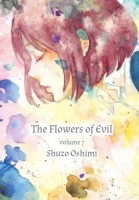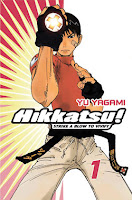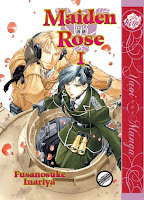My News and Reviews
I was in Texas for much of last week, attending a conference for work, but I was still able post a few things here at Experiments in Manga. The most recent manga giveaway is underway, for one. This month you all have a chance to win the first omnibus of Hiromu Arakawa’s Fullmetal Alchemist. All you have to do is tell me a little about some of your favorite women mangaka. April’s Bookshelf Overload was also posted; there were all sorts of great releases last month. And finally, the first in-depth manga review of May goes to the very recently released Vinland Saga, Omnibus 3 by Makoto Yukimura. Vinland Saga is one of my favorite series currently being published in English. The entire series is epic and third omnibus is awesome.
Because I was traveling and caught up in conference goings-on, I may have missed some news. (If there’s something that caught your interest last week, do let me know!) However, I did come across a few things that made for good reading. I particularly enjoyed Tony Yao’s post at Manga Therapy, The Ambiguously Amazing Hange Zoe which discusses things like Attack on Titan, gender, and ambiguity. I recently reviewed Jen Lee Quick’s Off*Beat, Volume 2 in preparation for the release of the third and final volume. The series’ editor Lillian Diaz-Przybyl offers some Editorial Thoughts on the End of Off*Beat, one of Chromatic Press’ flagship titles. RocketNews24 offers a list of the twenty most popular manga in Japan, based on publication numbers. Justin Stroman interviews Eric Eberhardt (Viz Media’s Director of Digital Publishing) about Viz’s new digital imprint VIZ Select.
And for those of you in the Toronto area next week and weekend, do be sure to check out the Toronto Comic Arts Festival! There will be some phenomenal programming and incredible creators in attendance (including Moyoco Anno, Est Em, and Akira Himekawa among many, many more), and it’s free! TCAF is the only comic festival/conference that I go to and I highly, highly recommend it.
Quick Takes
 Constellations in My Palm written by Chisako Sakuragi and illustrated by Yukine Honami. I happen to really enjoy Honami’s artwork—a somewhat softer style with light but expressive lines—so I’ve slowly been getting around to reading the various boys’ love manga that she’s worked on. As far as I know, Constellations in My Palm is the only manga that Sakuragi has written. It’s a fairly realistic romance and tends to be somewhat quiet and subdued. It’s narrated by Mizuho, a college student, whose younger cousin Enji moves in with his family as he is about to start college, too. When they were younger they were very close, but it’s been seven years since they’ve been in contact with or seen each other. Mizuho and Enji both care about each other, but their relationship has become awkward and strained. Constellations in My Palm has some wonderful moments in it, but I was largely frustrated by the manga. So much of the story is driven by misunderstandings, and many of them aren’t even the result of miss-communication. Generally, it’s Mizuho who’s the culprit—even when he’s told something straight to his face, repeatedly, he simply can’t or chooses not to believe it. As Mizuho has some self-esteem issues this does fit his character, but it doesn’t make it any less exasperating.
Constellations in My Palm written by Chisako Sakuragi and illustrated by Yukine Honami. I happen to really enjoy Honami’s artwork—a somewhat softer style with light but expressive lines—so I’ve slowly been getting around to reading the various boys’ love manga that she’s worked on. As far as I know, Constellations in My Palm is the only manga that Sakuragi has written. It’s a fairly realistic romance and tends to be somewhat quiet and subdued. It’s narrated by Mizuho, a college student, whose younger cousin Enji moves in with his family as he is about to start college, too. When they were younger they were very close, but it’s been seven years since they’ve been in contact with or seen each other. Mizuho and Enji both care about each other, but their relationship has become awkward and strained. Constellations in My Palm has some wonderful moments in it, but I was largely frustrated by the manga. So much of the story is driven by misunderstandings, and many of them aren’t even the result of miss-communication. Generally, it’s Mizuho who’s the culprit—even when he’s told something straight to his face, repeatedly, he simply can’t or chooses not to believe it. As Mizuho has some self-esteem issues this does fit his character, but it doesn’t make it any less exasperating.
 The Flowers of Evil, Volumes 7-9 by Shuzo Oshimi. I’ve been waiting for the entirety of the third arc of The Flowers of Evil to be released before reading it. I’m glad that I did, because once I started I didn’t want to put the manga down. After the resolution of the incident at the summer festival, there is a timeskip of three years. Kasuga and his family have moved to a different town in order to start over, but he is still haunted by his past. His relationship with his parents is broken and almost nonexistent. His new classmates tolerate him, but he remains distant and disconnected (and understandably so). But then he meets and, despite his weirdness and strange behavior, is befriended by Tokiwa—a popular and attractive girl whom all of the boys have a crush on. Like Kasuga, she’s hiding parts of herself from others, too. On the surface, the third arc is almost tame when compared to what came before it, but it is still extremely effective. It has a very different sort of intensity than the previous arcs. The story has become more subtle but retains a constant undercurrent of dread. Even when good things happen it seems as though they could only possibly be a prelude to some sort of disaster. The Flowers of Evil is an incredibly engaging series and just keeps getting better and better.
The Flowers of Evil, Volumes 7-9 by Shuzo Oshimi. I’ve been waiting for the entirety of the third arc of The Flowers of Evil to be released before reading it. I’m glad that I did, because once I started I didn’t want to put the manga down. After the resolution of the incident at the summer festival, there is a timeskip of three years. Kasuga and his family have moved to a different town in order to start over, but he is still haunted by his past. His relationship with his parents is broken and almost nonexistent. His new classmates tolerate him, but he remains distant and disconnected (and understandably so). But then he meets and, despite his weirdness and strange behavior, is befriended by Tokiwa—a popular and attractive girl whom all of the boys have a crush on. Like Kasuga, she’s hiding parts of herself from others, too. On the surface, the third arc is almost tame when compared to what came before it, but it is still extremely effective. It has a very different sort of intensity than the previous arcs. The story has become more subtle but retains a constant undercurrent of dread. Even when good things happen it seems as though they could only possibly be a prelude to some sort of disaster. The Flowers of Evil is an incredibly engaging series and just keeps getting better and better.
 Say I Love You, Volume 1 by Kanae Hazuki. I didn’t really know much about Say I Love You before reading the first volume; I was vaguely aware of the series because of its recent anime adaptation (which I haven’t seen yet), but that’s about it. There’s not really much of a “hook” per se in Say I Love You. The characters are fairly normal. The story isn’t particularly unusual. The the two leads are Mei Tachibana—who although she avoids making friends is very aware of others and their feelings—and Yamato Kurosawa—whose popularity stems from his good looks but who otherwise is extremely average. So far the manga is simply about a group of teenagers living out their high school years. This includes all of the cliques and the bullying, the stress caused by interpersonal relationships, the self-consciousness and the issues of self-esteem. But that realism is probably the series’ strength. Say I Love You has some humorous moments, but I wouldn’t really describe it as a comedy at this point since in general Hazuki takes a more serious approach with the series. I’m actually very curious to see how Mei and Yamato’s relationship continues to develop, as well as how the relationships between the other characters evolve as well.
Say I Love You, Volume 1 by Kanae Hazuki. I didn’t really know much about Say I Love You before reading the first volume; I was vaguely aware of the series because of its recent anime adaptation (which I haven’t seen yet), but that’s about it. There’s not really much of a “hook” per se in Say I Love You. The characters are fairly normal. The story isn’t particularly unusual. The the two leads are Mei Tachibana—who although she avoids making friends is very aware of others and their feelings—and Yamato Kurosawa—whose popularity stems from his good looks but who otherwise is extremely average. So far the manga is simply about a group of teenagers living out their high school years. This includes all of the cliques and the bullying, the stress caused by interpersonal relationships, the self-consciousness and the issues of self-esteem. But that realism is probably the series’ strength. Say I Love You has some humorous moments, but I wouldn’t really describe it as a comedy at this point since in general Hazuki takes a more serious approach with the series. I’m actually very curious to see how Mei and Yamato’s relationship continues to develop, as well as how the relationships between the other characters evolve as well.
 Wolfsmund, Volumes 3-4 by Mitsuhisa Kuji. At first Wolfsmund seemed to me as though it was going to be an episodic series, but with the third and fourth volumes the manga has focused in on an overarching narrative. However, the bleakness and brutality that has been present from the very start of Wolfsmund remains constant. These volumes see the beginning of the Swiss rebellion against the Austrian occupation and all of the violence and death that entails, including the incredible siege of the Wolf’s Maw at Sankt Gotthard Pass. The uprising has been in the planning stages for quite some time, but now the rebels finally have the opportunity to take action. 14th-century warfare is not pretty. There are very good reasons why attacking an overtaking a fortress are difficult tasks to accomplish—they are built to withstand assault and are designed to allow defenders to wreak havoc on invading forces and to cause tremendous amounts of damage. The rebels must face skilled soldiers, traps, fire, molten lead, boiling water, and more. And on top of that Wolfram, the bailiff of the Wolf’s Maw, is a vicious and sadistic leader who is not above torture. In fact, he seems to delight in it. Wolfsmund continues to be a dark and intense manga that is definitely meant for maturer audiences.
Wolfsmund, Volumes 3-4 by Mitsuhisa Kuji. At first Wolfsmund seemed to me as though it was going to be an episodic series, but with the third and fourth volumes the manga has focused in on an overarching narrative. However, the bleakness and brutality that has been present from the very start of Wolfsmund remains constant. These volumes see the beginning of the Swiss rebellion against the Austrian occupation and all of the violence and death that entails, including the incredible siege of the Wolf’s Maw at Sankt Gotthard Pass. The uprising has been in the planning stages for quite some time, but now the rebels finally have the opportunity to take action. 14th-century warfare is not pretty. There are very good reasons why attacking an overtaking a fortress are difficult tasks to accomplish—they are built to withstand assault and are designed to allow defenders to wreak havoc on invading forces and to cause tremendous amounts of damage. The rebels must face skilled soldiers, traps, fire, molten lead, boiling water, and more. And on top of that Wolfram, the bailiff of the Wolf’s Maw, is a vicious and sadistic leader who is not above torture. In fact, he seems to delight in it. Wolfsmund continues to be a dark and intense manga that is definitely meant for maturer audiences.












